
and Supernova 2011fe.

M101 was first observed by Pierre Méchin on 27th March 1781, but not recognised as a spiral until Lord Ross observed it with his 72-inch reflector in 1851. It is 170,000 light-years in diameter and 21 million light-years away. It is interestingly asymmetric and includes a number of bright knots in its spiral arms, some of which have their own NGC classifications. It is the largest galaxy in its own cluster of galaxies which is a part of the local supercluster.
Supernova 2011fe exploded 21 million years ago and its light was first detected by the Palomar Transit Factory on 24th August 2011. It is of Type 1a which makes it particularly important as this type of supernova always has the same absolute brightness so they can be used to estimate distances to their host galaxies. Also in this case it is believed that the light was detected within a day or two of its first reaching Earth, so that the very earliest stages of the explosion can be studied.
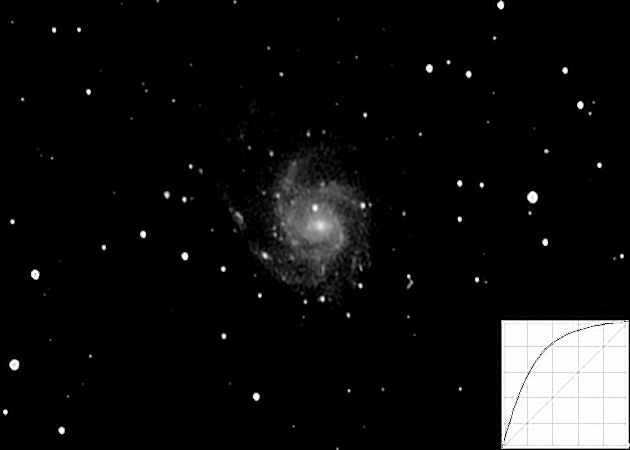 |
This is my first attempt at this galaxy. Conditions were not good, and the fainter parts of the spiral arms have disappeared into the general sky-glow, but I am reasonably pleased with the result. Date and Time: 25th April 2010 21:35 - 22:02 UT Camera: MX716 Telescope: ST80 with skyglow and IR-block filters Capture: star_mx7. Exposure 60 sec, 25 frames Processing: star_mx7, dark subtraction, and initial enhancement factor 25 on each frame. RegiStax5. 24 frames stacked, histogram 32-208, Gaussian wavelet 1(0.2) = 0, gamma curve (see inset). Focus Magic 4,100 |
||
This picture was taken in March 2020 and so is out of sequence. But it seems more sensible to put any new pictures here rather than after the sequence of pictures of the supernova. I have scaled it to suit the pictures below rather than the one above. I am not presenting it as an example of a particularly good image, which is is not, but as an example of what can be dragged out from very unpromising originals. Move your mouse pointer over the image and you will see one frame from the original collection. Dragging this image out of these involved extreme stretching of the histogram, a delicate manipulation of the gamma curve, and adjustment of the colour balance.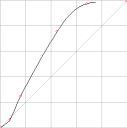 Date and Time: 26th March 2020 22:00 - 22:20 UT
Date and Time: 26th March 2020 22:00 - 22:20 UTCamera: Canon 1100D DSLR Telescope: 8-inch Ritchey-Chrétien Capture: Canon_EOS. Exposure 60 sec, 20 frames Processing: RegiStax5. 20 frames stacked, final histogram 40-60, gamma curve as here. |
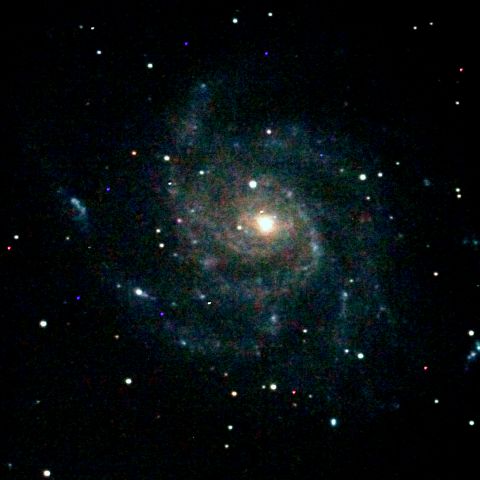 |
||
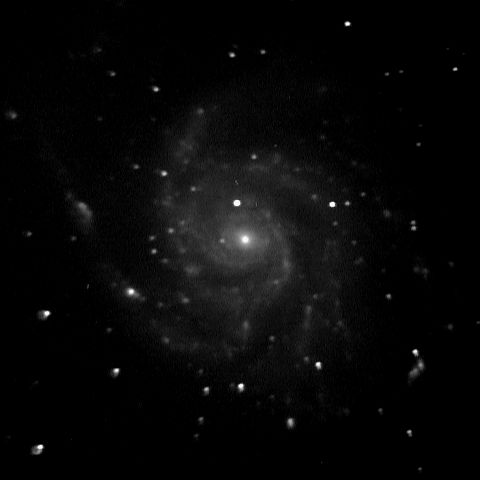 |
My second attempt at this galaxy is with my LX200 and 0.33 focal reducer*. Conditions were a little better but I still needed the Orion Skyglow filter. Date and Time: 17th May 2010 23:32 - 23:41 UT Camera: MX716 Telescope: LX200 with 0.33 Focal Reducer and skyglow and IR-block filters Capture: star_mx7. Exposure 120 sec, 5 frames Processing: star_mx7, dark subtraction, and initial enhancement factor 25 on each frame. RegiStax5. 5 frames stacked, histogram 129-255. Focus Magic 4,100. PhotoImpact brightness -5. *The coma on the stars to the lower left is caused by a defective focal reducer—see picture below. |
||
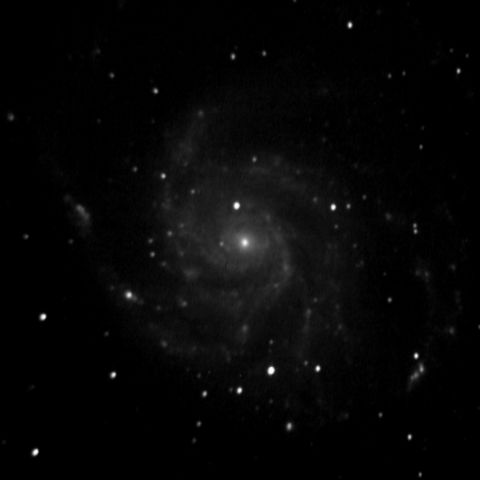 |
A type-1a supernova, PTF 11kly, was discovered in M101 on 24 August 2011 at magnitude 17.2. This type of supernova brightens considerably in the days after ignition, and it is undoubtedly brighter than that in this picture taken 4 days later. By moving your mouse pointer over the image, you can see a comparison of this image with the one above, showing the new star very clearly. (This picture was taken using my much-improved focal reducer which has given a slight difference in scale for which I have been unable to compensate fully.) Date and Time: 28th August 2011 21:43 UT Camera: MX716 Telescope: LX200 with 0.33 Focal Reducer and CLS filter Capture: star_mx7. Exposure 60 sec, 5 frames Processing: star_mx7, dark subtraction, and initial enhancement factor 25 on each frame and flat correction. RegiStax6. 5 frames stacked, histogram 6-255. |
||
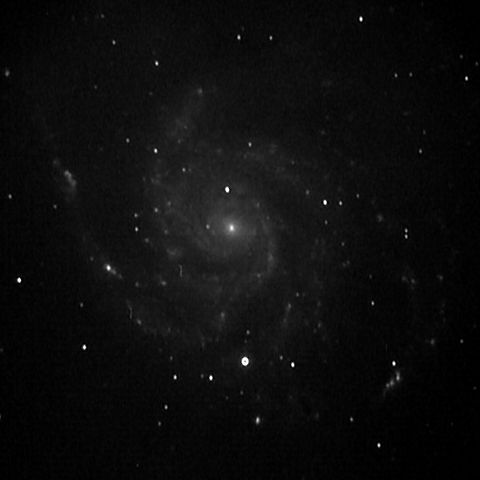 |
Here we have M101 again with the supernova (now known as SN 2011fe) 17 days after discovery. Because of the considerable enhancement that I give these pictures in order to bring out the galaxy, the fact that the supernova is much brighter here than in the picture above may not be obvious. So below I reproduce three pictures in smaller format that are not enhanced. Unfortunately the original pictures taken in 2010 were taken with a 120-second exposure whereas those taken this year were with 60 seconds exposure. I have tried to compensate for this by reducing the contrast. Date and Time: 10th September 2011 20:13 to 20:35 UT Camera: MX716 Telescope: LX200 with 0.33 Focal Reducer and CLS filter Capture: star_mx7. Exposure 60 sec, 10 frames Processing: star_mx7, dark subtraction, and initial enhancement factor 25 on each frame. RegiStax6. 10 frames stacked, histogram 6-255. |
||
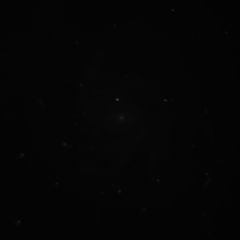 |
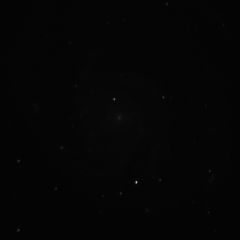 |
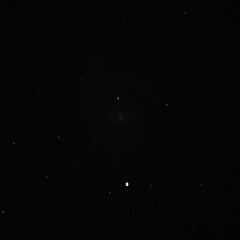 |
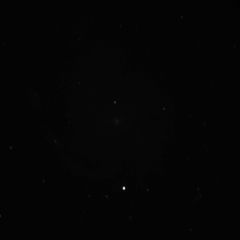 |
| 17 May 2010 | 28 August 2011 | 10 September 2011 | 13 September 2011 |
| According to a graph published by the American Association of Variable-Star Observers the magnitude of SN 2011fe was 12.5 on 28th August and was at its maximum of 10 on 3rd September. At the time of writing, their data did not extend after 3rd September. | |||
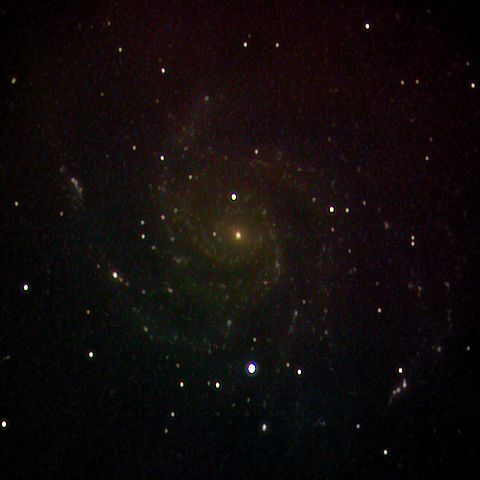 |
And now the galaxy and SN 2011fe imaged three days later, this time in LRGB colour. I have added the unenhanced image to the sequence above—is it my imagination or has it dimmed a little? Date and Time: 13th September 2011 20:36 - 21:43 UT Camera: MX716 Telescope: LX200 with 0.33 Focal Reducer and Astronomik CLS and RGB filters Capture: star_mx7. Exposure 60 sec, 10 frames for CLS, 5 frames for each of R, G, B Processing: star_mx7, dark subtraction, and initial enhancement factor 25 on each frame. RegiStax6. All frames stacked. Gaussian wavelets Scheme 3, de-ring dark side 300. Focus Magic 2,100. PhotoImpact gamma 1.2. |
||
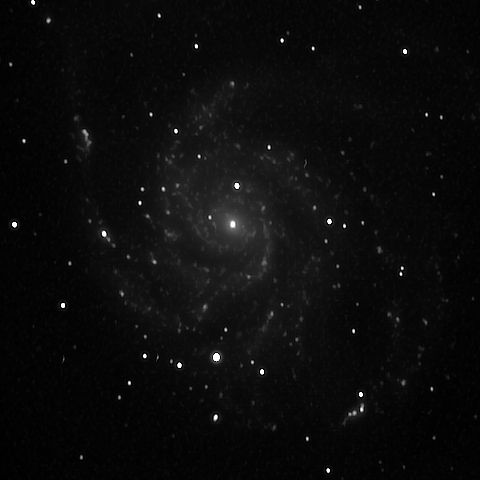 |
And now the galaxy and SN 2011fe imaged eleven days later. Since I am doing this to monitor the supernova, I have gone back to monochrome. I have started a new sequence of unenhanced images below including a copy of the image from 13th September for comparison. Date and Time: 24th September 2011 20:35 - 21:44 UT Camera: MX716 Telescope: LX200 with 0.33 Focal Reducer and Astronomik CLS filter Capture: star_mx7. Exposure 60 sec, 10 frames Processing: star_mx7, dark subtraction, and initial enhancement factor 25 on each frame. RegiStax6. All frames stacked. Gaussian wavelets Scheme 3, de-ring dark side 300. Focus Magic 2,100. |
||
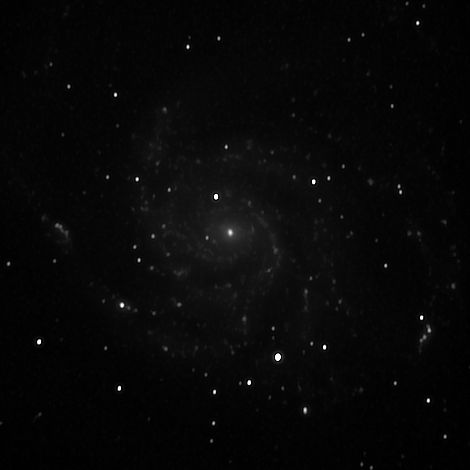 |
The galaxy and SN 2011fe imaged six days later. I have added an unenhanced image to the sequence below. Date and Time: 30th September 2011 19:38 - 19:53 UT Camera: MX716 Telescope: LX200 with 0.33 Focal Reducer and Astronomik CLS filter Capture: star_mx7. Exposure 60 sec, 10 frames Processing: star_mx7, dark subtraction, and initial enhancement factor 25 on each frame. RegiStax6. All frames stacked. Gaussian wavelets Scheme 3, de-ring dark side 300. Focus Magic 2,100. |
||
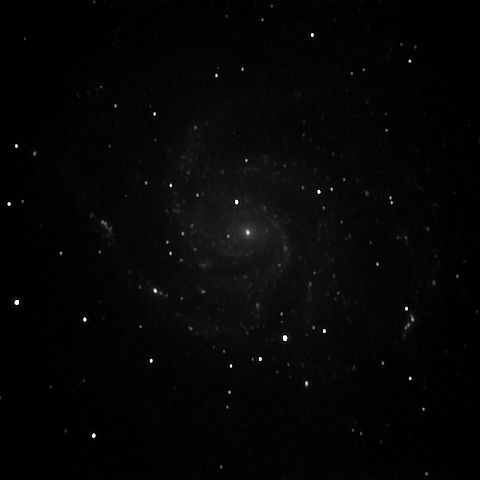 |
The galaxy and SN 2011fe imaged another two weeks later. The unenhanced picture is below. The supernova has faded a little but is still an easy object. Date and Time: 7th October 2011 19:54 - 20:06 UT Camera: MX716 Telescope: LX200 with 0.33 Focal Reducer and Astronomik CLS filter Capture: star_mx7. Exposure 60 sec, 9 frames Processing: star_mx7, dark subtraction, and initial enhancement factor 25 on each frame. RegiStax6. All frames stacked. Gaussian wavelets Scheme 3, de-ring dark side 300. Focus Magic 2,100. |
||
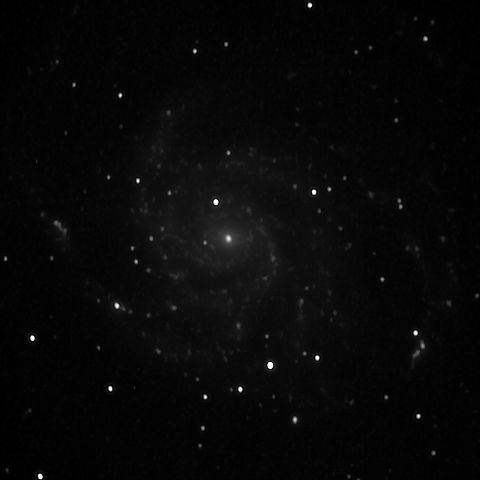 |
The galaxy and SN 2011fe imaged another 10 days later. The unenhanced picture is below. The supernova may have faded a little further but is still an easy object. Date and Time: 19th October 2011 19:41 - 19:51 UT Camera: MX716 Telescope: LX200 with 0.33 Focal Reducer and Astronomik CLS filter Capture: star_mx7. Exposure 60 sec, 10 frames Processing: star_mx7, dark subtraction, and initial enhancement factor 25 on each frame. RegiStax6. All frames stacked. Gaussian wavelets Scheme 3, de-ring dark side 300. Focus Magic 2,100. |
||
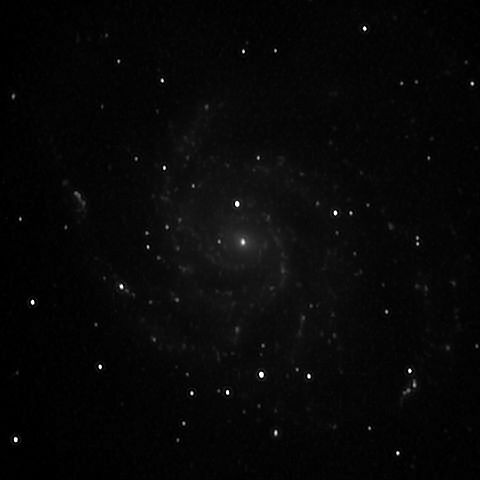 |
The galaxy and SN 2011fe imaged 2 weeks later. The unenhanced picture is below. The supernova continues to fade but is still an easy object. Date and Time: 1st November 2011 18:40 - 18:50 UT Camera: MX716 Telescope: LX200 with 0.33 Focal Reducer and Astronomik CLS filter Capture: star_mx7. Exposure 60 sec, 10 frames Processing: star_mx7, dark subtraction, and initial enhancement factor 25 on each frame. RegiStax6. 9 frames stacked (one spoiled by an aircraft). Gaussian wavelets Scheme 3, de-ring dark side 300. Focus Magic 3,100. |
||
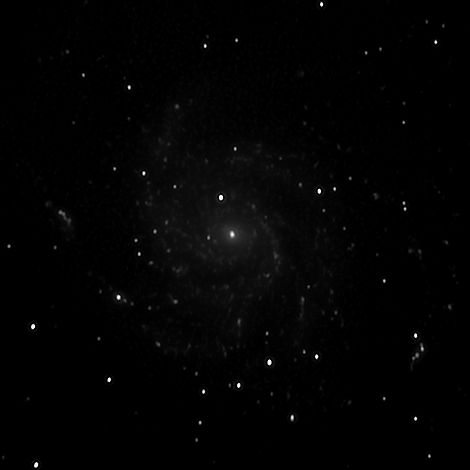 |
The galaxy and SN 2011fe imaged another 2 weeks later. The unenhanced picture is below. The supernova continues to fade and seems to me to be significantly dimmer than it was two weeks ago. Date and Time: 17th November 2011 18:32 - 18:43 UT Camera: MX716 Telescope: LX200 with 0.33 Focal Reducer and Astronomik CLS filter Capture: star_mx7. Exposure 60 sec, 10 frames Processing: star_mx7, dark subtraction, and initial enhancement factor 25 on each frame. RegiStax6. 10 frames stacked. Gaussian wavelets Scheme 3, de-ring dark side 300. Focus Magic 3,100. |
||
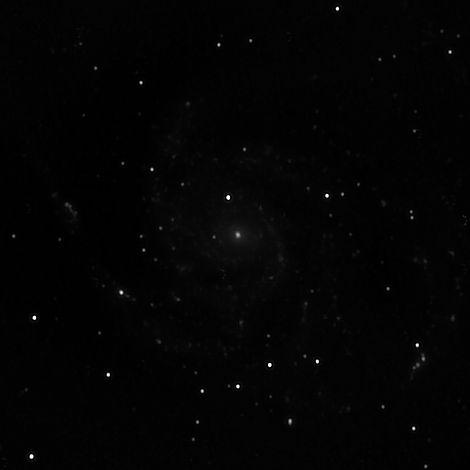 |
The galaxy and SN 2011fe imaged another 2½ weeks later. The supernova has faded significantly in the last two weeks. It may not look much fainter in the enhanced picture, but if you look at the unenhanced picture below, you will see that it is only a little brighter than the stars on either side of it. Date and Time: 5th December 2011 03:45 - 03:55 UT Camera: MX716 Telescope: LX200 with 0.33 Focal Reducer and Astronomik CLS filter Capture: star_mx7. Exposure 60 sec, 10 frames Processing: star_mx7, dark subtraction, and initial enhancement factor 25 on each frame. RegiStax6. 10 frames stacked. Gaussian wavelets Scheme 3, de-ring dark side 300. Focus Magic 2,100. |
||
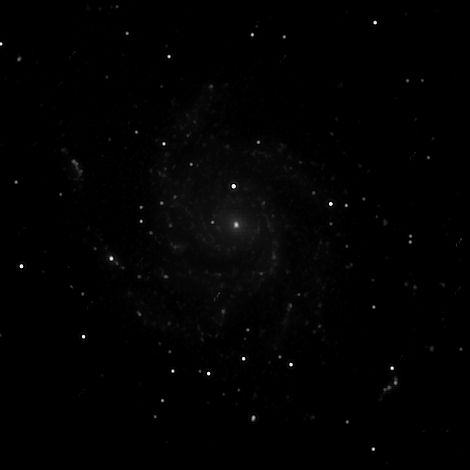 |
The galaxy and SN 2011fe imaged another 32 days later. The supernova has faded significantly in the last four weeks. It may not look much fainter in the enhanced picture, but if you look at the unenhanced picture below, you will see that it is now about the same brightness as the stars on either side of it. The best time to image this galaxy is now the early morning when it is almost overhead. However conditions were not too good with high-level cloud, so I have enhanced this image rather more than usual. I've added the unenhanced image to the sequence below. Date and Time: 6th January 2012 06:47 - 06:57 UT Camera: MX716 Telescope: LX200 with 0.33 Focal Reducer and Astronomik CLS filter Capture: star_mx7. Exposure 60 sec, 10 frames Processing: star_mx7, dark subtraction, and initial enhancement factor 25 on each frame. RegiStax6. 10 frames stacked. Gaussian wavelets Scheme 3, de-ring dark side 300. PhotoImpact. Focus Magic 2,100, gamma 1.2, brightness -10. |
||
I have added two more unenhanced images to the sequence below. I have not included the enhanced versions. They are no better and no worse than the images above, and I think I have enough for one page. I have also updated the graph to reflect data to 20 March 2012. I should emphasise that the line on this graph is the sum of two exponential curves (one for the rise and one for the decay), and I have no a priori reason to suppose that supernovae follow exponential rise and decay. Also the line is fitted to the data from Rochester by eye. The curve predicts a final magnitude of 16.8, which is almost certainly too high—it was 17.1 when discovered and well below that before it exploded.
 |
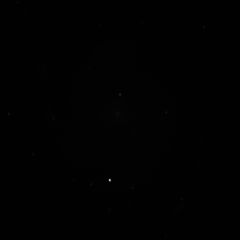 |
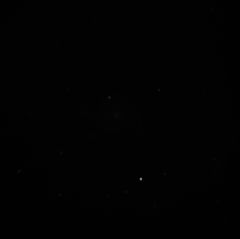 |
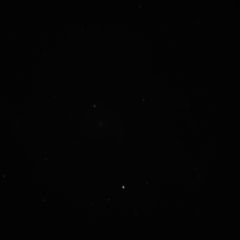 |
| 13 September 2011 | 24 September 2011 | 30 September 2011 | 8 October 2011 |
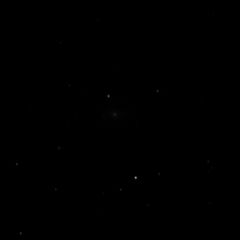 |
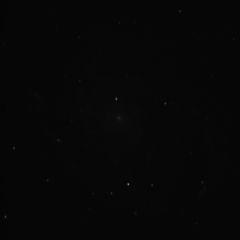 |
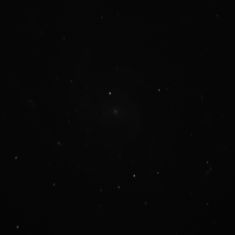 |
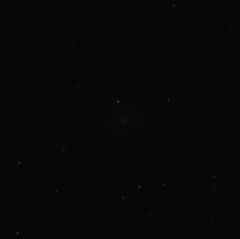 |
| 19 October 2011 | 1 November 2011 | 17 November 2011 | 5 December 2011 |
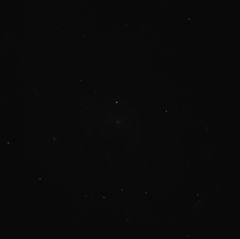 |
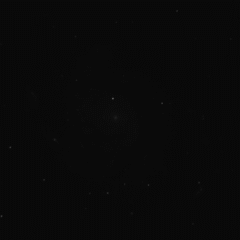 |
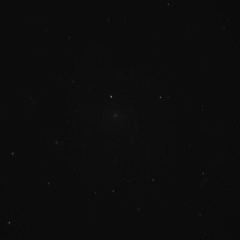 |
|
| 6 January 2012 | 1 February 2012 | 20 March 2012 |
The American Association of Variable-Star Observers has reported that the magnitude of SN 2011fe was 12.5 on 21st October. Rochester Astronomy has a report that the supernova had reached to magnitude 15.7 on 19th March 2012. My result on 20th March 2012 is 15.4.
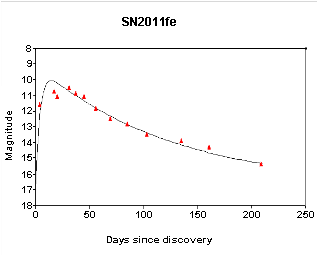 I have used my pictures to try to estimate the magnitude of SN2011fe. To do this I have compared the supernova with the two stars that are either side of it. I have been unable to find the magnitudes of these two stars, but I could estimate the difference in magnitude between the supernova and the average of these two stars by measuring the signal from them using the eyedropper tool in PhotoImpact. I then calibrated my results using the data from the Astronomy Section of the Rochester Academy of Science for 24th September 2011. In this graph, the line is the light curve of the supernova as estimated from the data published by Rochester and the red triangles are my estimations. I am pleased with the general agreement.
It is evident that I have under-estimated the brightness of the supernova at its maximum. The reason for this is that, at that time, I was over-exposing the supernova and the signals were too close to saturation of the camera.
I have used my pictures to try to estimate the magnitude of SN2011fe. To do this I have compared the supernova with the two stars that are either side of it. I have been unable to find the magnitudes of these two stars, but I could estimate the difference in magnitude between the supernova and the average of these two stars by measuring the signal from them using the eyedropper tool in PhotoImpact. I then calibrated my results using the data from the Astronomy Section of the Rochester Academy of Science for 24th September 2011. In this graph, the line is the light curve of the supernova as estimated from the data published by Rochester and the red triangles are my estimations. I am pleased with the general agreement.
It is evident that I have under-estimated the brightness of the supernova at its maximum. The reason for this is that, at that time, I was over-exposing the supernova and the signals were too close to saturation of the camera.
Home Back to DSOs